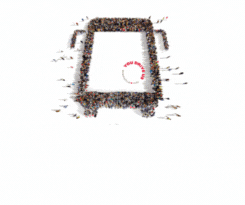
Ahead of the charge – going electric in Turku
19 August 2024
by Eurocities
When Turku first launched its work on electric vehicle charging, it was too early. Back in 1999, the city’s 13 free public car charging stations generated a lot of excitement but very little use. By that time, the city itself had already had two electric vans for postal delivery running for four years, but it would be some time before public interest picked up.
Searching for a company to provide an electric bike sharing system back in 2018, the city found that there were still no suitable suppliers on the market. However, fast forward to today, and the city operates a fleet of electric buses and has even electrified its iconic city ferry, Föri. The residents of Turku are catching up too, with estimates that 25,000 private electric cars may be operating in the city by the end of the decade.
With numbers expanding so rapidly, now it was the city’s turn to catch up.
“We needed some concrete planning because the market had already changed a lot by 2020,” says Jussi Saari, from Turku’s Traffic and Mobility Department. “We needed a clear plan for the hundreds of chargers we wanted to install.” The eight operating chargers in the public space at the time, most installed around 2016, were built by the municipal company Turku Energia. Moving forward, Turku is opting for a market-driven approach. “We wanted a clear market solution, not investing more as a city,” he adds.
Eight hundred years to climate neutrality
Turku aims to become climate neutral in time for its 800th birthday in 2029. A large part of this effort will involve reshaping its transport sector, including through electric mobility. To achieve this, it needed to put an ambitious electromobility master plan in place, primarily centred around car charging facilities.
To ease this process, the city joined the EU-funded project UserChi, supported by Eurocities, to gain insights from other cities on the same journey.
“We knew about a good example of an electromobility masterplan from Stockholm and wanted to create our own version. We needed to make actual, real plans that can be implemented here in the future years,” Saari recalls.
Saari emphasises the value of international collaboration and learning.
“Overall, we got a lot out of the UserChi project and it was important for our internal development. It’s good to have partners that have already had experiences to learn from,” he says.
With the plan now completed, Saari is optimistic that it may be approved and implemented already by the end of 2024.
Power over quantity
Rather than focusing solely on the number of chargers, Turku’s plan prioritises the overall power availability.
“We don’t need to decide that we need 2,000 chargers because if we have one high speed charger, it can charge the same amount as ten slow chargers during the day,” Saari explains.
The city aims to make available 3kw per electric car and 0.66kw per plug-in hybrid – about 44 megawatts of charging power overall, “power is our goal, not quantity,” Saari emphasises.
The strategic deployment of chargers considers different user needs, with ultra-fast chargers planned for high-traffic areas and moderately fast chargers near amenities like restaurants and shops.
“We also wanted to ensure that we have slower chargers, 22kw and slower, for offices and residential areas outside homes,” Saari adds.
In considering the location of the chargers, Turku made use of UserChi’s ‘CLICK‘ tool. Click is a digital platform designed to enhance the planning and deployment of electric vehicle charging stations in cities and major transport corridors. It allows for customisable planning according to user needs and local specifics, integrating a variety of data inputs like road networks, existing infrastructure, and geographical information from sources. The platform supports dynamic scenario simulations and adjustments based on actual usage data, facilitating both the initial setup and ongoing expansion of charging networks.
Engaging users
These decisions were not made by municipal experts alone. The types and locations of chargers were decisions made as a result of a consultation of around 500 Turku residents – one that yielded some results that surprised operators and experts. Previously, the governing wisdom was that chargers should always be placed next to services like restaurants and shopping centres. It was thanks to this citizen consultation exercise, which also allowed people to choose their preferred location for chargers on a map, that it became clear that different types of chargers were best suited to different locations.
While they wanted different charging options, something users made it clear that they were sick of was being forced to download a lot of different mobile apps.
“What was the most often cited problem was that there were quite a lot of operators, they all had their own application,” Saari relates, “They all had different problems with their application that demanded, before you even charge, quite a big deposit of money to even start charging. It was quite a messy situation – some chargers worked fine, some not at all.”
Turku is tackling that problem by ensuring that every charger installed on public land will have an option to pay directly with your credit card – no apps necessary. New European regulations will soon make this mandatory for fast chargers, but Turku is ahead of the curve.
The big advantage, says Saari, is that it reduces market friction and encourages real competition: “You don’t have to stick with one operator, you can choose the closest and the cheapest.”
The survey also validated the city’s impulse to make more public charging available, revealing that large numbers of people were interested in owning electric cars but lacked any way of charging such vehicles at their homes.
At present, there are already a growing number of publicly available charging stations on private property, for example in the carparks of department stores.
“We are glad that private companies are making public charging points, and it’s good for us,” says Saari. “The biggest supermarket chains in Finland are also the biggest charging point operators,” he reveals.
Keeping electric bikes safe
Turku is not looking to see a simple switch from private fossil-fuel powered cars to private electric cars, which is not a compelling solution to the world’s ecological challenges. Other forms of mobility, like electric public transport and good-old-fashioned walking are part of the plan too. Electric bicycles also feature, but here the needs are quite different – more related to security than charging.
“The need for electric bike charging is quite low, even though we have more and more electric bikes each year,” Saari observes. This trend is partly due to government-subsidised, tax-free bike programmes through companies, which have boosted e-bike ownership. However, “because they have such a long range and people are biking 10 to 20 km per day, people are charging at home or at work, so there is not that much need for public charging.”
Nonetheless, Turku was interested in trialling one of the bike-charging technologies being trialled through the UserChi project, the InSoc e-bike and e-scooter charging station with a solar panel canopy that uses solar power for bike charging. However, the planned design was not suitable for the harsh winters accompanied by heavy snowfall that are characteristic of Finland.
This led to a localised redesign: “We planned the bike garage ourselves with four walls and gave it to the company, who built it last year,” Saari recalls. The structure, equipped with solar panels and battery storage, offers parking for 40 bikes and is conveniently located near the train station, promoting multimodal transport connectivity. The garage remains accessible at all times and is equipped with security cameras to ensure safety while remaining open for public use: “It’s as secure as it can be while remaining open.”
Electrifying public enthusiasm
The encouraging trend towards electric mobility among Turku’s residents has not come about all on its own. Besides technological advances and global trends, the shift owes a lot to the city’s consistent communication campaigns.
Public engagement extended to events and media. During Mobility Week each year, Turku promotes its fleet of over 80 electric buses, highlighting the environmental benefits of choosing public transport. The city also observes International Car Free Day, encouraging alternative, more sustainable modes of transport.
Turku even ventured into podcasting, producing a series in Finnish focused on electric mobility. This series, hosted by urban mobility specialist Jalmari Salaterä, features interviews with experts and experienced individuals, offering a comprehensive perspective on electric mobility. This initiative aimed to educate and inspire listeners about the benefits and possibilities of electric transportation.
A shared journey
Turku’s journey of enhancing its electric mobility through UserChi over the past four years is mirrored in the journey of Jussi Saari himself.
“When I started here in Turku, I was on an internship. Now I’ve been working four years in these electric charging initiatives,” he says.
Living quite far from central Turku where he works, he wasn’t initially convinced that an electric car would be a suitable option, and he was concerned about how well one might function when subjected to Finland’s -25 degree winters. As you may have guessed, by now he’s taken the plunge. “I have seen that an electric car works even for longer trips, and I have gained enough trust to buy one for myself.”
This article originally appeared on Eurocities.







